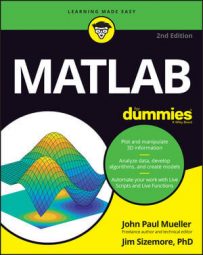You need to know which operators MATLAB supports, but remember them all isn't easy. The following table provides a brief summary of the operators that MATLAB supports.
| Operator | Type | Description | Example |
|---|---|---|---|
| - | Arithmetic | Subtracts the right operand from the left operand. | 5 - 2 = 3 |
| * | Arithmetic | Multiplies the right operand by the left operand. | 5 * 2 = 10 |
| ^ | Arithmetic | Calculates the exponential value of the right operand by the left operand. | 5^2 = 25 |
| / | Arithmetic | Divides the left operand by the right operand. | 5 / 2 = 2.5000 |
| Arithmetic | Divides the right operand by the left operand. | 5 2 = 0.4000 | |
| + | Arithmetic | Adds two values together. | 5 + 2 = 7 |
| . | Arithmetic | Modifies operators to perform element-by-element arithmetic vis-à-vis matrix arithmetic. You receive no modification if you're operating on scalars (ordinary numbers). | [1,2]*[3;4] = 11 [1,2].*[3,4] = [3,8] |
| = | Assignment | Assigns the value found in the right operand to the left operand. | MyVar = 2 results in MyVar containing 2 |
| bitand | Bitwise | Performs a logical and of the bits in two numbers. | bitand(4, 5) = 4 |
| bitor | Bitwise | Performs a logical or of the bits in two numbers. | bitor(4, 5) = 5 |
| bitget | Bitwise | Obtains the value of the bit at a specific location. | bitget(4, 3) = 1 |
| bitset | Bitwise | Changes the bit at the specified location. | bitset(4, 1, 1) = 5 |
| bitshift | Bitwise | Shifts the bits the specified number of positions. | bitshift(2, 1) = 4 |
| bitxor | Bitwise | Performs a logical exclusive or on the bits in two numbers. | bitxor(4, 5) = 1 |
| and | Logical | Determines whether both operands are true. | and(true, true) = 1 (or true) and(true, false) = 0 (or false) and(false, false) = 0 and(false, true) = 0 |
| not | Logical | Negates the truth value of a single operand. A true value becomes false and a false value becomes true. | not(true) = 0 not(false)=1 |
| or | Logical | Determines when one of two operands are true. | or(true, true) = 1 or(true, false) = 1 or(false, false) = 0 or(false, true) = 1 |
| xor | Logical | Determines when one and only one of the operands is true. | xor(true, true) = 0 xor(true, false) = 1 xor(false, false) = 0 xor(false, true) = 1 |
| all | Logical | Determines whether all the array elements are nonzero or true. | all([1, 2, 3, 4]) = 1 all([0, 1, 2, 3]) = 0 |
| any | Logical | Determines whether any of the array elements are nonzero or true. | any([0, 1, 0, 0]) = 1 any([0, 0, 0, 0]) = 0 |
| ~= | Relational | Determines whether two values are not equal. | 1 ~= 2 is 1 (or true) |
| < | Relational | Verifies that the left operand value is less than the right operand value. | 1 < 2 is 1 |
| <= | Relational | Verifies that the left operand value is less than or equal to the right operand value. | 1 <= 2 is 1 |
| == | Relational | Determines whether two values are equal. Notice that the relational operator uses two equals signs. A mistake many developers make is using just one equals sign, which results in one value being assigned to another. | 1 == 2 is 0 |
| > | Relational | Verifies that the left operand value is greater than the right operand value. | 1 > 2 is 0 |
| >= | Relational | Verifies that the left operand value is greater than or equal to the right operand value. | 1 >= 2 is 0 |
| - | Unary | Negates the original value so that positive becomes negative and vice versa. | -(-4) results in 4 while -4 results in -4 |
| + | Unary | Provided purely for the sake of completeness. This operator returns the same value that you provide as input. | +4 results in a value of 4 |

